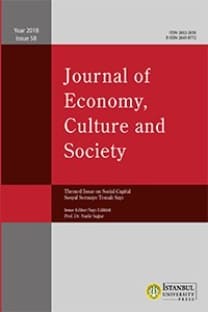Maliye Politikalarının Kapsayıcı Büyüme Üzerine Etkisi Türkiye Örneği
Günümüzde ülkeler yoksulluk, gelir eşitsizliği ve işsizlik ile aynı anda mücadele etmek için kapsayıcı büyümeyi hedeflemektedir. Kapsayıcı büyüme hedefine yönelik politikalar ülkeye göre farklılık göstermektedir. Ancak maliye politikaları, büyümeyi daha kapsayıcı hale getirmek için önemli bir rol oynamaktadır. Bu çalışmada öncelikle Türkiye ekonomik büyümesinin kapsayıcı olup olmadığını ölçmek için beş farklı endeks hesaplanmıştır. Büyümenin kapsayıcı olduğu sonucu elde edildikten sonra hesaplanan endeksler kapsayıcı büyüme göstergesi olarak kullanılmış; eğitim, sağlık, sosyal transfer ve vergileri içeren maliye politikalarının kapsayıcı büyümeyi hangi yönde etkilediği araştırılmıştır. 2006-2018 dönemini kapsayan analizlerde yıllık veriler kullanılmış, maliye politikaları ile kapsayıcı büyüme arasındaki ilişki ARDL analizi ile test edilmiştir. Çalışma sonucunda kapsayıcı büyüme endekslerinin maliye politikalarından farklı şekilde etkilendiği tespit edilmiştir. Elde ettiğimiz sonuçlar, sağlık ve eğitime yönelik kamu harcamalarının kapsayıcı büyüme endeksleri üzerinde azaltıcı bir etkiye sahip olduğunu göstermiştir. Sosyal transferler kapsayıcı büyüme endeksini olumlu yönde etkilerken, dolaylı vergilerin iki kapsayıcı büyüme endeksini olumsuz yönde etkilediği gözlemlenmiştir.
Anahtar Kelimeler:
Kapsayıcı Büyüme, Maliye Politikaları, Kapsayıcı Büyüme Endeksi, Inclusive growth, Fiscal policies, Inclusive growth index
The Impact of Fiscal Policies on Inclusive Growth in Turkiye
Countries aim to inclusive growth to find a common solution the problems that poverty, income inequality, and unemployment. To boost inclusive growth, policies differ by country but fiscal policies play a crucial role in making growth more inclusive. In this study, five different indices were calculated to measure whether Turkish economic growth was inclusive. After obtaining the result that growth is inclusive, the calculated indices were used as the inclusive growth indicator, and we inquired in which direction the fiscal policies on education, health, social transfers, and taxes affect inclusive growth. Annual data covering the period 2006-2018, and the ARDL method were used to test the relationship between fiscal policies and inclusive growth. We figured out that fiscal policies had different effects on created inclusive growth indices. The results obtained show that public expenditures for health and education have a decreasing effect on inclusive growth indices while social transfers contributed positively to inclusive growth index, two indices were negatively affected by indirect taxes.
Keywords:
Inclusive growth, Fiscal policies, Inclusive growth index,
___
- Ali, I., & Son, H. H. (2007). Measuring inclusive growth. Asian Development Review, 11-31. google scholar
- Asian Development Bank. (2014). Asian Development Bank outlook 2014: fiscal policy for inclusive growth. Metro Manila, Philippines: Asian Development Bank. google scholar
- Bloom, D. E., Canning, D., & Sevilla, J. (2001). The effect of health on economic growth: theory and evidence. NBER Working Paper Series-8587. google scholar
- C20. (2015). C20 Inclusive growth working group policy paper. Retrieved from: https://ingev.org/wp-content/ uploads/2018/06/INCLUSIVE-GROWTH.pdf google scholar
- Chakrabartty, S. (2017). Composite index: methods and properties. Retrieved from: https://www.researchgate.net/ publication/321268796_Composite_Index_Methods_and_Properties google scholar
- Çakmak, E., & Gümüş, S. (2005). Türkiye’de beşeri sermaye ve ekonomik büyüme: ekonometrik bir analiz (19602002). Ankara Üniversitesi SBF Dergisi, 60 (1), 59-72. google scholar
- Estrada, G., Lee, S.-H., & Park, D. (2014). Fiscal policy for inclusive growth: an overview. ADB Economics Working Paper Series. google scholar
- Gupta, S., Verhoeven, M., & Tiongson, E. (2001). Public spending on health care and the poor. IMF Working Paper Series. google scholar
- Hakimian, H. (2013). The search for inclusive growth in North Africa: a comparative approach. African Development Bank-AfDB. google scholar
- Heshmati, A., Kim, J., & Park, D. (2014). Fiscal policy and inclusive growth in advanced countries: their experience and implications for Asia. ADB Economics Working Paper Series. google scholar
- IPC-IG. (2013). After all, what is inclusive growth? No. 188. The International Policy Centre for Inclusive Growth. google scholar
- Kiani, A., & Ullah, S. (2015). The inclusive growth index: a new measurement of Pakistan’s development. HEC 3rd International Social Science Conference Proceedings. google scholar
- Klasen, S. (2010). Measuring and monitoring inclusive growth: multiple definitions, open questions, and some constructive proposals. ADB Sustainable Development Working Paper Series, No. 12. Asian Development Bank. google scholar
- McKinley, T. (2010). Inclusive growth criteria and indicators: an inclusive growth index for diagnosis of country progress. ADB sustainable development working paper series. Asian Development Bank. google scholar
- OECD. (2012). Promoting inclusive growth, challenges and policies. Policy debate: how do you make growth more inclusive? OECD. google scholar
- OECD (2017, April 29). Retrieved from: http://www.oecd.org/inclusive-growth/ google scholar
- Sarısoy, İ., & Koç, S. (2010). Türkiye’de kamu sosyal transfer harcamalarının yoksulluğu azaltmadaki etkilerinin ekonometrik analizi. Maliye Dergisi(158), 326-348. google scholar
- Taşkın, T. (2014). GDP growth in Turkey:inclusive or not. Central Bank Review. 14 (2), 31-64. google scholar
- World Bank. (2009). What is inclusive growth? Retrieved from: http://siteresources.worldbank.org/INTDEBTDEPT/Resources/468980-1218567884549/WhatIsInclusiveGrowth20081230.pdf google scholar
- World Economic Forum (2017). The inclusive growth and development report 2017. World Economic Forum. google scholar
- ISSN: 2602-2656
- Yayın Aralığı: Yılda 2 Sayı
- Başlangıç: 1960
- Yayıncı: İstanbul Üniversitesi Yayınevi
Sayıdaki Diğer Makaleler
Traditional Treatment of Tuju Disease (Rheumatism) in Lontar Usada Based on Bali Local Wisdom
Putu Lakustini CAHYANİNGRUM, İ Ketut ARDHANA
Studies in Turkiye within the context of Gender: An Overview of Postgraduate Dissertations
Maliye Politikalarının Kapsayıcı Büyüme Üzerine Etkisi Türkiye Örneği
Improving Organizational Resilience in Businesses: A Qualitative Study on the Effect of COVID-19
Kadir AKSAY, A. Aslan ŞENDOĞDU
Elif ÖZUZ DAĞDELEN, Tuğça POYRAZ
COVİD-19 Pandemi Süreci ve Batı Akdeniz’deki Kadın Kooperatiflerini(N) Etkilemesi
